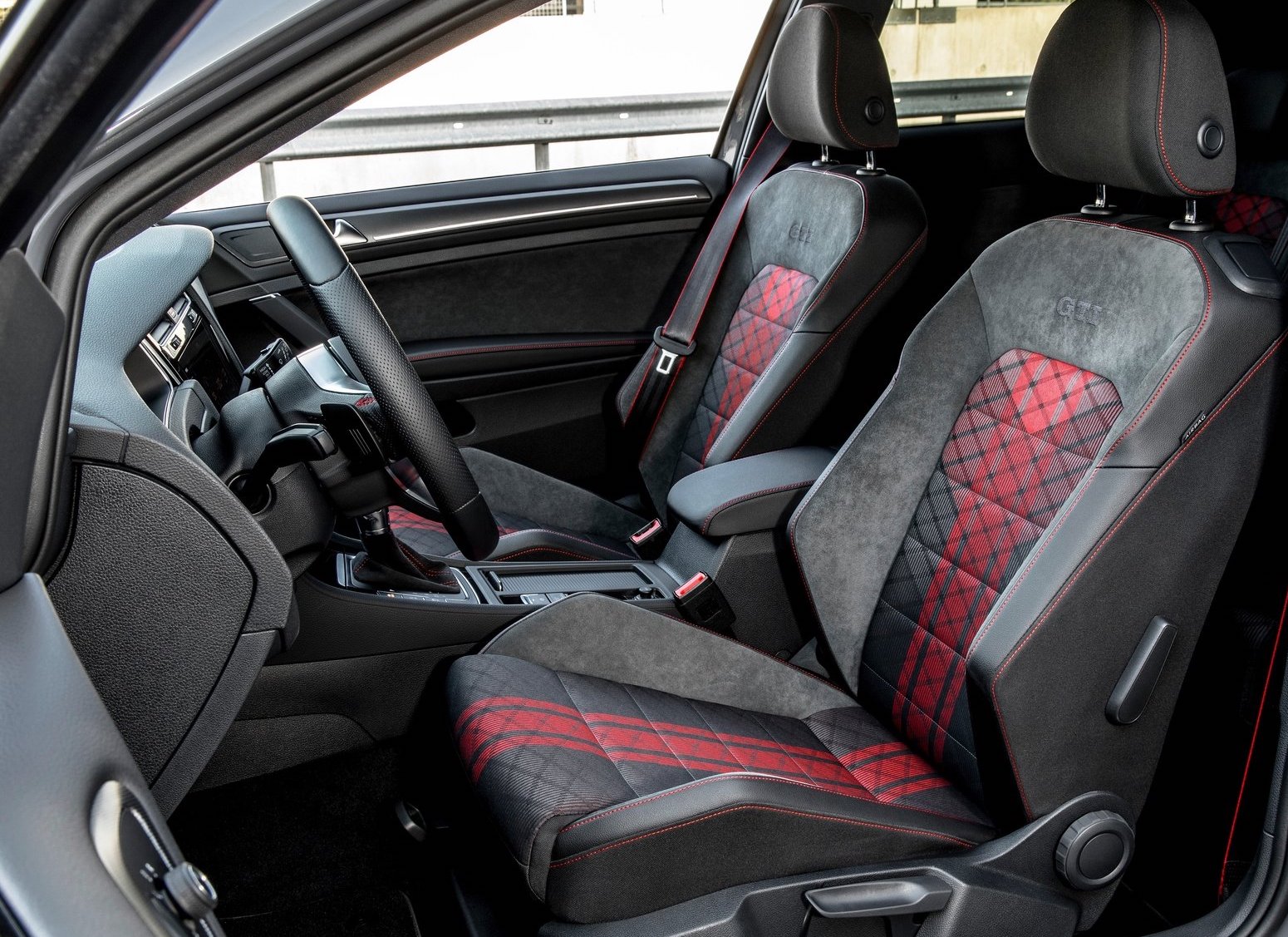Volkswagen Golf GTi 2020 Model Details & More

The car that defined the term “hot hatch” embodies a classic formula: refinement, style, power, and playful performance. In 2020, the Golf GTI returns with a host of enhancements that continue the tradition of affordable performance since its debut in 1983. The GTI has been awarded more than a dozen awards since its redesign for the 2015 model year, and in 2020 it only gets better. But this is the model name the Mk7.5 and most of us are waiting patiently for the arrival of the all new Volkswagen Golf Mk8 which is said to be more Audi than Volkswagen.
New for 2020
In a modest value realignment, Front Assist, Blind Spot Monitor, and Rear Traffic Alert are now standard equipment on all models. GTI models also receive standard in-car Wi-Fi capability when you subscribe to a data plan, and the next generation Car-Net® infotainment system.
An Autobahn Package is available and adds a host of upscale features, including a Discover Media infotainment system with navigation, Climatronic® automatic dual-zone climate control, Fender® Premium Audio, Adaptive Cruise Control, Lane Assist, and Light Assist.

Exterior
The seventh-generation car is wrapped in sheet metal that is modern, yet equally unmistakable as a Volkswagen Golf GTI. The shape and design elements remain as defined as ever, with a distinctive C-pillar, roofline framing, and classic Golf GTI side windows, but the striking new front end and steeply sloped hood leave no doubt this is different from previous generations.
S models feature standard LED Daytime Running Lights (DRLs), while LED headlights with the Adaptive Front-lighting System (AFS) are standard on SE models. A bright-red horizontal strip visually connects the headlights to a revised grille and bumper. Those fasciae carry a strong character line that travels along the side and all the way back to the taillight clusters, only breaking for the wheel arches. Just above, another body line can be traced from the rear side window all the way back up to the headlights. These subtle body lines help create a poised yet elegant appearance.
In addition to the red horizontal highlight on the grille, the 2020 Golf GTI has several other visual differences from its conventional Golf brethren. The lower front fascia incorporates standard LED fog lights housed within a series of horizontal strakes on either side of a unique mesh pattern grille. Red-painted brake calipers with “GTI” lettering peek behind bespoke alloy wheels and subtle side skirts help to give the GTI a more planted appearance. Around back, bright exhaust tips sit on either side of a unique rear diffuser, while a roof spoiler and LED taillights further differentiate the car.
The Golf GTI has a lower visual center of gravity and a more dynamic stance than the regular Golf, thanks to a sport suspension that lowers the car by 0.6 inches. The Golf GTI is equipped with large 18-inch aluminum-alloy wheels as standard equipment, wrapped in standard all-season or, exclusively optional on the SE trim with Autobahn Package, 225/40 summer performance tires.
Automatic rain-sensing windshield wipers along with automatic headlights are standard across the lineup.

Interior
The large, mature cabin has an emphasis on comfort and a substantial features list. There is 93.5 cu-ft of interior room, along with 16.5 cu-ft of luggage space up to the parcel shelf and 22.8 cu-ft to the roof – space that rivals even the largest midsize sedan. The versatility of the load space is enhanced by a trunk floor that can be raised or lowered, while the 60:40 split backrest can be folded to give an almost flat cargo area that can accommodate a full-size bicycle. With the rear seats folded, the Golf GTI has 52.7 cu-ft of cargo capacity.
In addition to the spacious interior, the driver controls are positioned to help optimize ergonomics and usability. The seat position, height of the shifter and the spacing between the pedals are fine-tuned for increased driver comfort. This driver-centric design focus is evident from the center stack, which is angled towards the driver—a trait frequently seen in premium luxury or performance vehicles.

The Golf GTI’s premium performance personality is further accentuated from the regular Golf model by the red ambient lighting and illuminated door sills; black headliner and trim inserts; buttons and switches that are backlit in white; and the use of premium materials and soft-touch plastics throughout. A GTI-specific instrument cluster, sporty aluminum-look pedals, the unique shifter knob, and the flat-bottomed sport steering wheel also ensure differentiation from its less-sporty siblings.
An equal amount of attention has been paid to helping maximize comfort and convenience. The standard front sport seats, with classic GTI “Clark” plaid seating surfaces, can be heated, and there are six cup holders. Cruise control switches and media controls are housed on the leather-wrapped and red-stitched multifunction steering wheel.
The Golf GTI S includes a leather-wrapped multifunction steering wheel, ambient and footwell lighting with LED reading lights, LED fog lights, and Driving Mode Selection. SE models add with KESSY® keyless access with push-button start, a sunroof, and leather seating surfaces.
The Autobahn Package adds standard DCC® adaptive damping, Climatronic automatic dual-zone climate control, auto-dimming rearview mirror, 12-way power driver’s seat, and the highly-acclaimed Fender Premium Audio.
MIB II Infotainment. All 2020 Golf GTI models feature Volkswagen’s innovative MIB II touchscreen infotainment system. The display utilizes a capacitive-touch sensor (as in smartphone and tablet technology) rather than the more common resistive touchscreens that require pressure, enabling gesture controls like swiping and even pinch-zooming.
The GTI S is equipped with the Composition Color unit, which features a 6.5-inch capacitive touchscreen display. The infotainment system also offers SD card and new USB-C (one port) multimedia interfaces, as well as a rearview camera and standard Bluetooth® technology for compatible devices. App-Connect smartphone integration for compatible devices is standard, and offers users the ability to run select smartphone apps directly on the vehicle’s display through services such as Apple CarPlay®, Android AutoTM and MirrorLink®.
The GTI SE is equipped with a glass-covered 8.0-inch capacitive touchscreen display with the Composition Media unit. The Autobahn Package includes the Discover Media system with navigation. Both units offer one USB-A port, a JPEG viewer, SiriusXM® radio for a three month trial period, and HD Radio. Both units also have the ability to send and receive SMS text messages via Bluetooth with compatible phones can and pair two phones simultaneously. The Discover Media unit offers 2.5D navigation, featuring one-shot voice destination entry, typed destination entry with search and auto-complete, and predicts possible destinations based on frequently used routes.

Powertrain
In classic Volkswagen style, the Golf GTI is powered by a compact turbocharged engine. The 2.0-liter TSI® turbocharged and direct-injection unit that powers the Golf GTI is a member of the latest, third-generation EA888 engine family and is built in Volkswagen’s state-of-the-art factory in Silao, Mexico. The EA888 engine line is a masterpiece of modern engine design that balances performance, efficiency, and drivability in a lightweight, compact package.
The EA888 engine produces 228 horsepower (achieved using premium fuel) at 4,700 rpm, and torque peaks at 258 lb-ft, beginning at just 1,500 rpm and lasting until 4,500 rpm. It can be paired with either a six-speed manual transmission or an optional seven-speed DSG automatic transmission with Tiptronic, the most advanced such unit Volkswagen offers. The DSG transmission incorporates a Start-Stop System designed to save fuel, as well as a launch control feature.
When equipped with the six-speed manual transmission, the Golf GTI achieves an EPA-estimated fuel economy rating of 24 mpg in the city, 32 mpg on the highway, and 27 mpg in combined driving. EPA-estimated fuel economy for the 2020 Golf GTI optional six-speed DSG automatic transmission is currently pending EPA certification.
Chassis
The Golf GTI’s stamped steel body and chassis boasts a large percentage high-strength, hot-formed steel. This technology allows much of the chassis and body to be constructed from thinner and lighter parts without loss in strength.
The Golf GTI features a strut-type front suspension with lower control arms and a multilink rear suspension, both of which are controlled by coil springs with telescopic dampers. The Golf GTI has a lowered sport suspension, which is 0.6 inches lower than Golf TSI models. The front suspension includes a 24-millimeter anti-roll bar while the rear has a 20-millimeter version, 2 mm larger at the front and 1 mm thicker at the back compared with a regular Golf TSI model.
All 2020 Golf GTI models come equipped with brakes shared with the Golf R—using 13.4-inch front and 12.2-inch rear vented discs—and the torque-sensing limited-slip differential, dubbed VAQ. This electronically-controlled differential works in concert with the existing stability systems to help improve traction and performance. Tests at the Nürburgring Nordschleife track have shown lap-time improvements of more than eight seconds compared to Golf models without the differential.
The VAQ acts as a traditional limited-slip differential—which reacts by transferring a set amount of torque to non-slipping wheels when others lose traction—but adds to its effectiveness by monitoring the data from each wheel sensor at all times. Since this data includes both vehicle and wheel speed, as well as yaw and lateral g-force, the system can make precise adjustments to help maintain an optimum torque balance between the left and right front wheels. Up to a full 100 percent of torque can be transferred to either side, as opposed to the fixed “best guess” percentage seen in traditional limited-slip differentials. The result of this proactive (rather than reactive) system is the reduction of the understeer and torque steer that can afflict sporty front-wheel-drive cars.
DCC. The Golf GTI SE with the optional Autobahn Package features the latest version of the DCC adaptive damping system, which manages the suspension’s rebound and compression rates individually, helping to improve vehicle dynamics.
Driving Mode Selection. The Driving Mode Selection feature offers three modes on cars with the standard sport suspension: “Normal,” “Sport,” and “Individual.” Normal and Sport have a different steering heft and throttle response, while Individual allows a driver to tailor the steering and throttle. On cars with the DSG transmission, the Sport mode gives more aggressive shifts. The DCC adaptive damping system adds a fourth “Comfort” mode, putting the suspension dampers in their softest setting for a smooth highway ride and to their firmest setting in Sport for better cornering performance.
ESC Sport. Another standout feature on the Golf GTI is the ESC Sport function for very experienced drivers for use on closed courses, such as a racetrack. The system is activated by a two-stage switch on the center console. If the driver pushes the button once, the ASR (traction control) function is deactivated. When the button is pressed longer than three seconds, Electronic Stability Control (ESC) switches to the ESC Sport mode. In high-speed driving, such as on a racetrack, the ESC system operates at a higher threshold for even more agile handling. ESC can also be activated through the “Car” settings menu.
Progressive variable-ratio steering. The Golf GTI also features progressive variable-ratio electric power steering system. This is an elegant solution to help with a common problem with steering systems, which is that different speeds and maneuvers ideally require different steering rates. In this case, Volkswagen has spaced the teeth on the steering gear’s rack more tightly toward the center than on a normal rack. The lower steering ratio in the center means that the car can respond quickly when entering a turn, while the higher ratio at the ends of the rack can help reduce the amount of effort needed near full steering lock, such as when parking. The Golf GTI steering wheel goes from lock to lock in just 2.1 turns, whereas the standard Golf needs 2.76 turns.
Safety
To help protect occupants, the Golf GTI provides a combination of both passive and active safety systems. It features six airbags as standard (front and side airbags for front passengers and side curtain airbags for outboard seating positions), along with a number of electronic safety systems, such as an Anti-lock Braking System (ABS) and Electronic Stability Control (ESC).
A standard feature on the 2020 Golf GTI is Volkswagen’s Automatic Post-Collision Braking System. This builds on the premise that a collision is rarely a single, instantaneous action, but rather a series of events that follow the initial impact—the most significant of which can cause additional collisions. The Automatic Post-Collision Braking System helps address this, in certain crash scenarios, by applying the brakes when a primary collision is detected by the airbag sensors, thus potentially reducing residual kinetic energy and, in turn, the chance of additional damage.
The Golf GTI also includes Volkswagen’s Intelligent Crash Response System that shuts off the fuel pump, unlocks the doors, and switches on the hazard lights if the car is involved in certain types of collisions.
Driver-Assistance Technology
This 2020 Golf GTI offers a comprehensive suite of driver-assistance technology. Available features include: Forward Collision Warning and Autonomous Emergency Braking with Pedestrian Monitoring (Front Assist); Blind Spot Monitor; Rear Traffic Alert; Adaptive Cruise Control (ACC); Lane Keeping System (Lane Assist); Park Distance Control; Parking Steering Assistant (Park Assist); and High Beam Control (Light Assist).
Front Assist, standard on all models, is intended to warn drivers of potential frontal collisions (Forward Collision Warning) with vehicles and pedestrians, and in some cases provide automatic braking assistance (Autonomous Emergency Braking).
Within physical system limits, Forward Collision Warning warns the driver of potential critical front-end collision situations, both acoustically and visually by a warning symbol in the instrument cluster if the car is traveling above 18 mph. Furthermore, an automatic jolt of the brakes can warn the driver of the danger. If the driver fails to brake, or if the car is traveling below 18 mph, Autonomous Emergency Braking is activated to help slow the vehicle. If the brake pedal is applied but the driver brakes too lightly, the brake pressure is increased by the system (Braking Support).
Blind Spot Monitor is standard on all Golf GTI models. Blind Spot Monitor uses two radar sensors at the rear of the vehicle to scan the approaching traffic and is intended to warn drivers of the presence of other vehicles in adjacent lanes. If the driver uses the turn signal to indicate a lane change while a vehicle is detected in a blind spot, the system utilizes a flashing LED symbol in the outer area of the side mirrors. Even if the driver does not use a turn signal, the LED symbol in the mirror will illuminate if a vehicle is detected in the blind spot. The system is designed to help alert drivers in specific situations; stationary objects or oncoming vehicles do not trigger warnings, nor do vehicles more than one lane across away from the vehicle.
If combined with Lane Assist (optional on SE models via the Autobahn package, see below) the system not only warns the driver with the flashing LED symbol if a vehicle is detected in the blind spot, but within system limits, it can also countersteer to help keep the car in the lane even if the turn signal is on. If the driver still tries to steer out of the lane, the system will warn with an additional vibration of the steering wheel.
The Rear Traffic Alert system, standard on all models is intended to detect vehicles approaching from the side that may be difficult for the driver to see while reversing. The system offers a 180-degree view of the back of the car with a range of 65 feet, and will present a visual and an acoustic warning, if a potential collision with a crossing vehicle is detected. If the driver does not react, the system can apply the brakes to help mitigate and, in the best case, can prevent a collision. The system is activated by putting the car in reverse.
Adaptive Cruise Control (ACC), optional on SE models via the Autobahn package, uses a forward facing radar to maintain a set speed while helping maintain a set distance to the vehicle in front. The driver sets the speed and the desired spacing via buttons on the multifunction steering wheel and can further use those buttons to adjust and cancel the ACC function while the accelerator can be used to override the ACC function. Pressing the brakes always cancels the ACC function. All ACC-related system messages appear in the central multifunction display.
When the roadway ahead of the vehicle is clear, the system maintains the set speed. Golf GTI models fitted with ACC and DSG can match a vehicle in front and come to a stop if the vehicle in front does. If the car stands longer than three seconds, the driver can resume ACC control by pressing the accelerator pedal. Models equipped with manual transmissions will require the driver to take over reducing speed at approximately 18 mph.
Lane Keeping System (Lane Assist) is optional on SE models via the Autobahn package. When driving above 40 mph, if the system’s camera recognizes visible lane markings and, using a special algorithm, calculates that the vehicle is unintentionally straying from its lane without using a turn signal, Lane Assist actively countersteers to help keep the vehicle in the lane If the driver takes his or her hands off the wheel for a defined period of time, the system provides an audible warning and a visual signal in the instrument cluster, asking the driver to take over.
The system will not engage if it cannot properly detect lane markings. If the turn signal has been set before crossing a lane marking, the Lane Assist system will not engage or give a warning. The driver can override the system at any time by applying minimal force to the steering wheel.
Park Distance Control, optional on SE models via the Autobahn package, uses ultrasonic sensors located in the front and rear bumpers to monitor a range of up to approximately five feet in front or behind the vehicle. The system may activate below 9 mph and helps provide guidance when parking or in tight spaces. The system has audible and visual warnings when the car starts to approach parked cars or static objects of sufficient size from the front or rear.
Maneuver Braking, a part of the Park Distance Control system, is intended to mitigate or help prevent collisions with recognized static obstacles to the front and rear while the vehicle is maneuvered. The system is active between 1-6 mph. If the system detects a stationary object, it can apply the brakes automatically to help prevent or mitigate a collision. The system can be deactivated at any time using the touch display or permanently in the setup menu.
Parking Steering Assistant (Park Assist) is optional on SE models via the Autobahn package. This system can automatically steer the car into parallel and perpendicular parking spaces (the latter both forward and in reverse). While driving below 25 mph, pressing the Park Assist button in the center console will activate the system to scan the left and right sides of the vehicle for parking spots. By using the turn signal indicator, the driver can indicate which side of the road they would like to park. When the system detects a space, “Parking Space Found” will appear in the multifunction display. The driver only needs to activate the accelerator pedal and brake once a gear is selected, as Park Assist can automatically help steer the vehicle into the parking space. The driver can override or deactivate the steering assistance at any time by turning the steering wheel, or pressing the button.
High Beam Control (Light Assist), optional on SE models via the Autobahn package, helps provide drivers with better visibility. The system automatically switches on the headlamp high beams above 37 mph on dark or poorly lit roads, if there is no oncoming traffic detected. Below 18 mph, the high beams automatically switch off.





